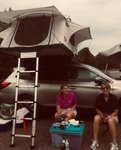


Every month I need to have my article to the editor by a certain deadline. And every month, around the beginning of the second week, I realize I have nothing. With deadline getting closer and closer, I used to panic but not anymore, because something always turns up.
Last week I started waiting. A couple of days went by with nothing happening, no chance remarks to put me on the trail, no significant dreams.
Then one morning when the article was the furthest thing from my mind, Jimmy told me to look across the road. Expecting to see a stray bag of trash some RVer had left, or maybe a couple of deer, instead I saw two women sitting in front of a little tent, which happened to be perched on top of their SUV! And even more amazing, another SUV was parked behind them and IT HAD A TENT ON TOP TOO!
Okay, I can tell you are not impressed. What’s the big deal? you’re wondering. A while back, I did an article on RVing in Iceland and rooftop tents are popular there, but these were the first I had seen here in the US. I grabbed my notebook and ran over to interrupt their peaceful morning coffee.
Both women, Laura and Louise, are from Albuquerque, and have been friends all their lives. Laura is retired and Louise is a pediatric physical therapist, and every summer they take off on an outdoor adventure for several weeks. Louise also is a serious bicyclist and goes to lots of bike races, where a couple of years ago she noticed quite a few rooftop tents. Last year she and Laura bought their Tepui brand tent from REI and did an initial tour of national parks in Utah, Montana, and California. “We stayed in a hotel one night, but missed our tent,” Louise told me. “We love it.” Even though at one park they had to evacuate because of a bear sighting.
“Wait a minute,” I interrupted, “aren’t you safe that high up?” Turns out bears can climb onto car hoods.
I carefully climbed the ladder to peek at the inside space, which is mostly filled with a large mattress. It looked comfortable, but later I read in the product specs that most of these tents have a 2 1/2-inch foam mattress. I thought about my own 12-inch mattress and speculated that a nice thick mattress pad might be called for if you happen to have bones that are close to their use-by date.
Normally these campers are self-sufficient foodwise, but Louise admitted to forgetting the stove for this trip, which is how they happened to stay here at Rose Valley RV Ranch. During dinner the previous evening at the Little Toad Creek Brewery and Distillery in downtown Silver City, they asked the waitress if she knew of a place for them to camp for the night. A young man at the next table introduced himself — Nick from Yorkshire, England, on a month-long camping trip through our Southwest—and told them he knew of a place. And by an amazing coincidence, he also was camping in a rooftop tent.
They all generally camp in national forests because disbursed camping, as it is called, is free as long as you’re 100-200 feet from any road, trail, or water source. As they described some of their experiences, I flashed back to their bear story. They described going through their first big wind in the tent: (“Frightening, but the tent held fast.”)
We discussed the drawbacks of the rooftop tent, especially the danger in a middle-of-the-night descent when nature calls.
“No liquid after 6 p.m.,” Louise insisted, while Laura declared the first step “a doozy.” And no drinking parties, they warned, although Nick told us he had a positive experience with that, strictly as research, of course.
I watched them fold up their nighttime shelter, which took them about 10 minutes. Supposedly this process can be done by a single person if they’re tall enough. Watching what seemed to me a somewhat complicated routine, I wondered just how tall that would have to be.
Nick’s tent is a Smittybilt Icamp and is similar to the Tepui. Rooftop tents come in both hard and soft-sided models; the latter seems roomier, but thinking of those bears, I know which I’d choose. Soft-sided tent prices range from around $1500 to $2500, while hard-sided are a little more expensive. I do question the description of many of these tents that they “sleep four,” since the largest I found was 72” wide by 96” long by 52” high. Maybe four really small or really young or really friendly campers. Some have sky panels for extra light, and no-see-um-proof mesh screens. They can also be mounted on a truck bed, which would seem to make access and assembly easier. So many of us are suffering from traveling deprivation right now, and these rooftop tents seem to be one cost-effective way to explore new places without risking your safety. Well, except for that bear thing.
All three campers mentioned the inconvenience that once the tent is set up, they don’t have use of the vehicle for sightseeing. But all brought along bicycles to compensate.
I bid the travelers goodbye and wished them safe journeys. I marveled at my good fortune in living right across the lane from where they spent the night, and at their willingness to share their adventures and experiences with a stranger. It was tempting to believe they had been sent here by divine providence for the purpose of this article, but to be honest, it’s a rare day when there’s not something intriguing happening at this RV park.
Sheila and husband, Jimmy, have lived at Rose Valley RV Ranch in Silver City since 2012, following five years of wandering from Maine to California. She can be contacted at sksowder@aol.com.